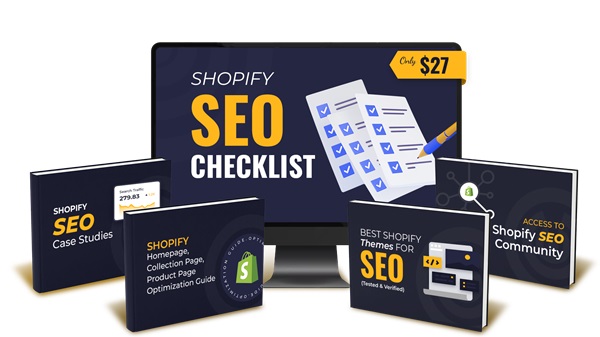Shopify SEO Checklist – Scaling Shopify Organic Traffic without Struggling OR Paying SEO Tools
$9.00
Discount 20% if your total cart over $150
- Satisfaction Guaranteed
- Fast and forever download link
- Secure Payments
- Reupload FREE
Description
The Shopify SEO Checklist promises a streamlined path to scaling your Shopify store’s organic traffic and revenue. But does it deliver? This article dives deep, exploring the checklist’s core principles, potential benefits, and whether it’s the right solution for your e-commerce business.
Shopify SEO Checklist
The Shopify SEO Checklist, often marketed as a groundbreaking shortcut, centers around optimizing the technical SEO foundation of your Shopify store. It proposes that a strong SEO foundation is often overlooked, and neglecting this aspect hinders the effectiveness of more traditional SEO endeavors like link building and content creation.

Benjamin Golden, the creator, positions himself as an SEO expert who, after facing frustrations with conventional strategies, discovered this alternative approach. The checklist promises a rapid return on investment (ROI) and actionable steps. It claims to help store owners gain a competitive edge, increase organic traffic, boost revenue, and ultimately create a semi-automated traffic generation system.
This approach allegedly circumvents the need for expensive backlinks, constant content updates, and continuous website speed optimizations – the usual suspects of SEO challenges. The core idea is simple: fix the critical technical SEO errors, turn them into SEO opportunities, and watch your rankings soar.
The checklist includes bonuses such as access to a community, additional resources, and a money-back guarantee, further sweetening the deal. The marketing relies heavily on the idea that the old ways of SEO are outdated and tiresome and that this new checklist is the key to solving those issues. The claim is that with this innovative method, you will see as much as 30-40% increase in organic traffic.
Technical SEO as the Foundation: Is It Really Neglected?
While the emphasis on technical SEO is not fundamentally wrong, painting it as a completely neglected area is partially misleading. Many Shopify store owners understand the importance of things such as meta descriptions, optimized image alt text, and site structure. However, it’s true that technical SEO can be daunting, and many might not know where to start or how to efficiently address technical issues.
That’s where a checklist can become useful, providing a guided path through potentially overwhelming technical SEO considerations. The value here lies in the simplification of a complex process, making it accessible to those without deep technical expertise or the budget to hire a dedicated SEO specialist. It is easy to feel lost when thinking about SEO, but this helps to address those concerns.
Technical SEO includes optimizing site speed, mobile-friendliness, site architecture, structured data, and crawlability. All of these aspects play a pivotal role in how search engines crawl, index, and rank your website. Neglecting these elements can result in lower rankings, reduced visibility, and decreased organic traffic. The truth is, you need to optimize these technical areas to give your site the best shot at performing well in search results.
Actionable Steps and Quick Wins: Separating Hype from Reality
The promise of “quick wins” and a simplified approach is one of the checklist’s biggest selling points and a factor in scaling Shopify organic traffic. However, it’s important to temper expectations. While a checklist format can provide actionable steps, the actual execution of these steps, as well as the resulting impact, will vary greatly depending on existing site conditions and market competitiveness.
Not every “quick win” is truly quick and can significantly vary from shop to shop. For example, fixing broken links can be fast, but optimizing page speed might require more complicated changes that demand technical expertise. Moreover, the term “quick win” can sometimes be misleading. While the checklist may guide users toward identifying and fixing a problem, the actual outcome of that fix – in terms of increased traffic and ranking – isn’t always instantaneous. It takes time for search engines to recrawl the site and re-evaluate rankings based on the changes made. Patience is needed.
The marketing around this checklist positions it as a remedy for Shopify users, who are typically not technical experts. The value in actionability is that the user can see a step-by-step format that addresses their most pressing SEO issues. This helps them understand the actions they are taking and how they affect their search rankings. This is what really adds value to the checklist.
Author Credibility: Trust the Messenger?
Benjamin Golden highlights his credibility by mentioning the generation of $25 million in Shopify sales through organic traffic. While such claims can inspire confidence, it’s important to remember that past performance doesn’t guarantee future success, and individual results may vary. Furthermore, the specific strategies employed to achieve those results might not be entirely encapsulated within the checklist. The success of an SEO strategy depends on numerous factors, including niche competitiveness, website quality, target audience, and broader market trends.
One of the biggest values in the Shopify SEO Checklist market is that the seller is not the traditional SEO expert. He has worked in SEO for years, so he does understand the market and know how to help those who are working in Shopify, however he markets himself as having this specific knowledge and expertise needed to work in the Shopify store and increase revenue. Shopify store owners may be skeptical in a sea of SEO specialists, but this expert is like them, which adds value. Because of this connection, it makes the marketing more convincing and feel less scam-like.
Scaling Shopify Organic Traffic
Scaling organic traffic for Shopify is more than just a quick fix; it’s about establishing a long-term strategy. It involves building a strong online presence, understanding your target audience, and continually optimizing your store to meet their needs. The claims made by the checklist are valid, and at a minimum, serve as a baseline to ensure you are following SEO practices that help generate organic traffic.
This part is vital for your Shopify store. The more SEO best-practices you follow, the better. Without this, your store is not optimized for search engines. The key is to understanding that having a Shopify storefront is not the solution, and it takes consistent work to generate real results. Understanding scaling organic traffic is an ongoing process of consistent effort.
Content and Backlinks: Are They Truly Obsolete?
The sales page claims the checklist avoids things like content writing or updating and building backlinks. While the checklist might initially focus on technical foundations, a truly comprehensive SEO strategy cannot ignore the power of high-quality content and strategic link building.
Content is still king, so it will never be obsolete. In fact, the Shopify SEO Checklist must work alongside other SEO strategies to ensure the best results. Content addresses customer questions and demonstrates expertise, which will generate traffic through quality keywords. Backlinks act as a digital vote of confidence from other websites, which boosts your domain authority and credibility in the eyes of search engines.
The statement “We don’t focus on content writing or updating…” raises serious concerns. Search engines like Google prioritize websites that offer valuable content. And if you do not create content, your search ranking will plummet because your storefront is not addressing problems or answering questions that customers are searching for. This part of the checklist should be discarded because high ranking websites are not afraid to update content or write a blog.
Understanding the “Shopify SEO Process Of Doom”
The term “Shopify SEO Process Of Doom” effectively captures the frustration many store owners experience with traditional SEO approaches. This is where the Shopify SEO Checklist really shows its value. Trying to jump into keyword research, endless content creation, and aggressively pursuing backlinks without a solid technical foundation can be incredibly overwhelming and lead to disappointing results. The focus on technical optimization first helps ensure that the store can even benefit from these wider SEO considerations.
However, the checklist has some things it needs to improve on to not be as overwhelming and to truly combat the process of doom. Some of its negative features include:
- Repetitive messaging: the constant repeating can turn people off of the checklist.
- Overly Simplistic Claims: there needs to be an understanding that an increase in traffic and/or conversions cannot be guaranteed.
- Discounted Prices: the seller is barely making anything when selling these checklists, so they may be banking on the idea that the user has enough value for the checklist to invest in other products or services.
Target Audience: Is It Right for You?
The Shopify SEO Checklist is targeted towards store owners and managers who seek a simpler, faster, and more cost-effective way to scale their organic traffic. If you’re feeling overwhelmed by the complexities and costs of traditional SEO, the checklist might provide a starting point. However, if you’re already well-versed in SEO and confident in your technical skills, the checklist might offer limited value. The offer seems to be targetted towards smaller, newer storefronts who are just getting started trying to optimize for searches. This checklist will likely be too basic for those with established storefronts who also have team members that address SEO, ad campaigns, and digital marketing full-time.
It’s also important to self-assess your time commitment and motivation. Fixing technical SEO issues requires time, effort, and potentially some learning. If you’re not willing to invest the necessary energy, the checklist will likely gather dust.
Five-Step System to Organic Traffic Growth.
Identify SEO quick-wins, sort them by ROI, implement, publish changes, and watch the organic traffic grow. These are the five steps to scaling organic Shopify traffic, and it sounds very straight to the point. The problem with the Shopify SEO Checklist system is that traffic does not typically happen overnight. Additionally, you may have to constantly work on the system in order to see real results. This could be seen as a deterrent, but it also shows commitment from the user. When a user is committed to making the system work, they are more likely to follow the checklist and make sure that the steps are actually being implemented and prioritized.
The checklist and system can benefit from a deeper dive into how to prioritize the SEO quick wins. This can be the difference in a person using the checklist or abandoning it. The user needs to understand how important each step is and what would be the most beneficial for them to implement. Furthermore, the user needs to understand how to implement it for the checklist to be useful.
Conclusion
The Shopify SEO Checklist presents an intriguing proposition – a simpler, faster, and more accessible path to scaling organic traffic for Shopify stores. It aims to address the common frustrations many store owners experience with traditional SEO methods by prioritizing technical SEO fundamentals and offering actionable steps. By investing in this product, you are also investing in scaling Shopify organic traffic.
However, it’s crucial to approach the checklist with realistic expectations. While it can provide a useful starting point and guide you through important technical optimizations, it’s not likely to be a magic shortcut that guarantees a 30-40% traffic increase within 90 days. A truly effective SEO strategy requires a holistic approach that combines technical excellence with high-quality content, strategic link building, and a deep understanding of your target audience.
Ultimately, the value of the Shopify SEO Checklist depends on your existing SEO knowledge, technical skills, and the specific needs of your store. If you’re a beginner seeking a structured approach to improving your store’s technical foundation, it might be worth considering. But if you’re already implementing a comprehensive SEO strategy, the checklist might offer limited additional value and might not lead to scaling Shopify organic traffic.
Sales Page:_https://go.goldenweb.net/shopify-seo-checklist





